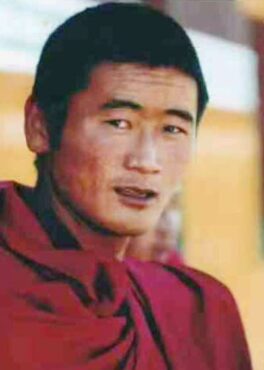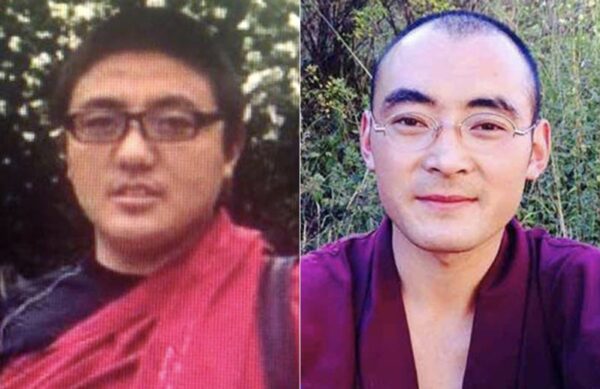Update: It was previously reported by the International Campaign for Tibet and Tibetan media that Lobsang Dorje had been arrested in 2011 and sentenced to three years in prison. It has since been confirmed that he was arrested in 2008 and sentenced to two years in prison, followed by a temporary detention in 2011. Lobsang Dorje was arrested again in 2018 and, after more than one year in detention, sentenced to three years in prison in September 2019.
- News of the disappearance and imprisonment of three monks has emerged from the Ngaba area of eastern Tibet, which has been subject to a brutal crackdown by the Chinese government since the wave of self-immolations began there in 2009.
- The fragments of details known about the three monks—two of who disappeared in 2017 and 2018—give glimpses into the endurance and determination of Tibetans in Ngaba despite the efforts of Chinese authorities to prevent any information from reaching the outside world.

Lobsang Thapke
The same exile monks, named Lobsang Yeshe and Kanyag Tsering, said that Lobsang Thapke is the son of Lokho, from the Lhade Gongma area of Ngaba (Chinese: Aba) county in Ngaba Tibetan and Qiang Autonomous Prefecture in Sichuan, in the Tibetan area of Amdo.
Lobsang Thapke joined Kirti monastery at a young age and was a graduate of the Buddhist Youth Academy at Kirti, which was closed down by the Chinese government. He then joined the philosophy college at Kirti and was studying in the Madhyamika class.
For centuries, Tibetan monasteries like Kirti have also served as centers of education and learning. This traditional system was nurtured in order to educate religious personnel and preserve Tibetan Buddhist civilization, but now it has been broken up and appropriated by the Chinese state, which has occupied Tibet since 1959. Today, monks are not allowed to travel freely between monasteries or on pilgrimage, and children are not allowed to study at monastic schools.
Other monks arrested in 2018, 2017

Lobsang Dorje and Thubpa
The two Kirti monks in exile also reported that it was only recently learned that former political prisoner Lobsang Dorje, a 36-year old Kirti monk, was arrested from his room at the monastery a year ago in August 2018 and has not been heard from since.
Lobsang Dorje—the son of Sangrin from the Chukle Gabma pastoral area of Ngaba county—had been arrested in 2011 and sentenced then to three years in prison. This is his second arrest. As a released political prisoner, he would have been under intense surveillance prior to his recent arrest. Former political prisoners are perceived by Chinese authorities as a continuing threat to the state and are often subjected to isolation, fear and anxiety, in addition to chronic health conditions as a result of their imprisonment and torture. Some do not survive.
The exile Kirti monks also said that information had only just reached them of the disappearance of 32 year-old Thubpa, a monk at Trotsik monastery in Ngaba, at the end of 2017. Thubpa was taken by police from his room at the monastery during the night and has not been heard of since. He is from the Garwa Tsang household in Tangwama village in Trotsik and joined the monastery at a young age. Like Lobsang Dorje, Thubpa is also a former political prisoner; he served 18 months of “reform through labor” after being charged for staging a protest, shouting slogans and burning the Chinese national flag on March 16, 2008 in Trotsik.
Kirti at the center of unrest
Kirti Monastery was at the center of the wave of protests in eastern Tibet following the 2008 anniversary of the March 10 Tibetan Uprising of 1959. Monks and laypeople took to the streets and called for freedom, displaying images of the Dalai Lama and home-made Tibetan national flags. In the brutal crackdown that followed, at least ten Tibetans were killed after police opened fire, and there were several hundred arrests in and around Kirti monastery. The crackdown in Ngaba has been brutal ever since.
The Kirti monks in exile received testimony at the time of the treatment in prison of those who protested in March 2008, saying: “More than 30 people were crammed into small rooms no larger than one pillar (approximately two meters square) in size. They had no room to sit and had to stand day and night. They were given one bowl of rice soup each per day, and were obliged to urinate and defecate where they stood. Educated and prominent individuals were singled out for especially harsh beatings.”
On the anniversary of this protest three years later, Thubpa’s father Kelsang participated in further protests and was imprisoned for an unknown period. This followed the self-immolation of a 20-year-old Kirti monk named Phuntsog on March 16, 2011, who called out “May His Holiness the Dalai Lama live for 10,000 years!” before setting himself on fire. After extinguishing the flames, police were observed beating Phuntsog before he died. Phuntsog’s self-immolation had an electrifying effect on Tibetans in Ngaba and was to prove significant as a catalyst for an outpouring of emotion and demonstration of solidarity among Tibetans in the area.
Rise of solo protests
As the frequency of self-immolations lessened in Ngaba from 2014 to 2018, Tibetans in Ngaba adopted a new form of peaceful protest: solo protest along the street in the county town, with protestors often bearing aloft an image of the Dalai Lama and calling for his return and for freedom. Most of the solo protests documented by the International Campaign for Tibet occurred in Ngaba. Not only were most of the self-immolations carried out in the same county town but also along the same road—which is being referred to as Heroes, or Martyrs, Street—by monks from the same monastery.
The desire to protect families and friends from the repercussions that follow self-immolations is likely to be a factor in the rise of solo protests. The Chinese authorities have responded to the more than 150 self-immolations in Tibet with an intensified wave of repression and by punishing Tibetans who allegedly ‘associated’ with those who set themselves on fire, including friends, families and entire communities.

